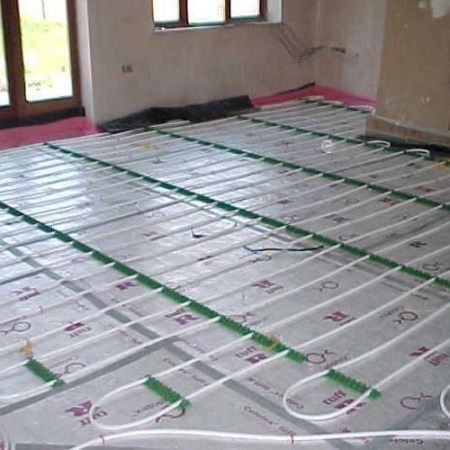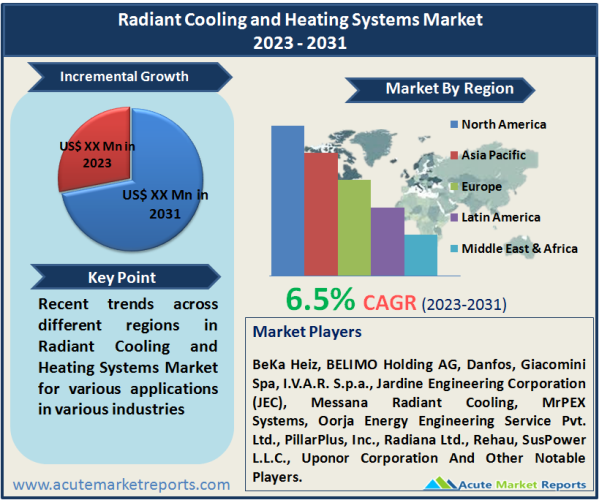
Radiant cooling and heating systems, also known as radiant HVAC (heating, ventilation, and air conditioning) systems, are innovative climate control solutions designed to provide thermal comfort and energy efficiency in indoor environments. These systems differ from traditional forced-air heating and cooling systems in how they distribute thermal energy within a building.The primary principle behind radiant systems is the transfer of heat directly from a warm surface to the objects and people in the room, creating a comfortable and uniform temperature distribution. This contrasts with traditional HVAC systems, which use air as the medium to transport hot or cold air throughout a space. Radiant systems leverage three main components to regulate indoor temperatures: a heat source, a distribution system, and a radiant surface. Radiant cooling and heating systems market is projected to grow at a CAGR of 6.5% from 2025 to 2033, driven by energy efficiency, improved thermal comfort, and design flexibility.

Energy Efficiency and Sustainability
Energy efficiency and sustainability have emerged as powerful drivers propelling the adoption of radiant cooling and heating systems. These systems operate by circulating water through pipes or panels embedded in floors, walls, or ceilings to regulate indoor temperatures. Radiant systems leverage the thermal mass of building structures to provide a consistent and comfortable environment, reducing the need for forced-air heating and cooling systems. As a result, they consume significantly less energy compared to traditional HVAC systems, leading to lower utility bills and reduced carbon emissions. With increasing awareness of environmental concerns and the emphasis on green building practices, radiant systems have gained popularity as a sustainable and energy-efficient alternative for climate control in residential, commercial, and industrial settings.
Improved Thermal Comfort and Indoor Air Quality
Radiant cooling and heating systems prioritize thermal comfort and indoor air quality, contributing to their adoption. Unlike traditional HVAC systems that distribute conditioned air unevenly, radiant systems provide consistent heating or cooling throughout a space. The even temperature distribution minimizes drafts, cold spots, and temperature fluctuations, creating a more comfortable environment for occupants. Additionally, radiant systems do not require the circulation of air, reducing the movement of dust, allergens, and pollutants. This results in improved indoor air quality, making radiant systems particularly appealing for applications where occupant well-being and health are paramount, such as healthcare facilities and educational institutions.
Design Flexibility and Aesthetics
Radiant systems offer design flexibility and aesthetics as a driver for their adoption. The integration of radiant panels or tubing into building structures allows architects and designers to optimize space utilization without the constraints of traditional HVAC equipment. Radiant systems are concealed within the building's surfaces, eliminating the need for visible vents, ducts, or radiators. This design freedom enhances the aesthetic appeal of interior spaces, enabling clean and unobtrusive architectural designs. The ability to create visually appealing, clutter-free environments aligns with contemporary design trends and has made radiant systems an attractive choice for both new construction and renovation projects.
Initial Installation Costs
An important restraint in the adoption of radiant cooling and heating systems is the initial installation cost. While these systems offer long-term energy savings and operational efficiency, the upfront expenses can be higher compared to traditional HVAC systems. Radiant systems require specialized equipment and materials for installation, including tubing or panels, a dedicated boiler or chiller, and skilled labor for proper integration into the building's structure. The complexity of the installation process, especially in existing buildings undergoing retrofitting, can contribute to higher labor costs. While the return on investment (ROI) through energy savings is attractive over time, some building owners may hesitate due to the initial capital outlay, particularly in budget-constrained projects.
Cooling Systems Dominate the Market by Type
The radiant cooling and heating systems market can be segmented by type, with heating systems expected to exhibit the highest CAGR. Radiant heating systems are well-established and widely adopted for their ability to provide efficient and comfortable heating.In terms of revenue, cooling systems are anticipated to lead the market. Radiant cooling systems offer energy-efficient cooling solutions, particularly in regions with high cooling demands.
Ceiling-Mounted Radiant Systems Dominate the Market by Installation Surface
The market segmentation by installation surface reveals that floor-mounted radiant systems are expected to have the highest CAGR. Floor heating and cooling systems benefit from the natural thermal mass of the building's structure.In terms of revenue percentage, ceiling-mounted radiant systems are likely to dominate the market. Ceiling panels offer discrete and unobtrusive cooling and heating solutions, aligning with modern design preferences.
Europe Remains as a Global Leader
Geographically, North America is expected to experience the highest CAGR in the radiant cooling and heating systems market. The region's emphasis on energy efficiency and sustainability aligns with the benefits offered by radiant systems.In terms of revenue percentage, Europe is projected to lead the market. European countries have a strong focus on green building practices and energy conservation, driving the adoption of radiant systems.
Competitive Trends
The radiant cooling and heating systems market features several key players, including BeKa Heiz, BELIMO Holding AG, Danfos, Giacomini Spa, I.V.A.R. S.p.a., Jardine Engineering Corporation (JEC), Messana Radiant Cooling, MrPEX Systems, Oorja Energy Engineering Service Pvt. Ltd., PillarPlus, Inc., Radiana Ltd., Rehau, SusPower L.L.C., and Uponor Corporation, among others. These companies compete by offering a range of radiant products and solutions tailored to specific applications. Key strategies in the market include product innovation, customization, and partnerships with architects and designers to promote the adoption of radiant systems.
Historical & Forecast Period
This study report represents analysis of each segment from 2023 to 2033 considering 2024 as the base year. Compounded Annual Growth Rate (CAGR) for each of the respective segments estimated for the forecast period of 2025 to 2033.
The current report comprises of quantitative market estimations for each micro market for every geographical region and qualitative market analysis such as micro and macro environment analysis, market trends, competitive intelligence, segment analysis, porters five force model, top winning strategies, top investment markets, emerging trends and technological analysis, case studies, strategic conclusions and recommendations and other key market insights.
Research Methodology
The complete research study was conducted in three phases, namely: secondary research, primary research, and expert panel review. key data point that enables the estimation of Radiant Cooling and Heating Systems market are as follows:
Market forecast was performed through proprietary software that analyzes various qualitative and quantitative factors. Growth rate and CAGR were estimated through intensive secondary and primary research. Data triangulation across various data points provides accuracy across various analyzed market segments in the report. Application of both top down and bottom-up approach for validation of market estimation assures logical, methodical and mathematical consistency of the quantitative data.
| ATTRIBUTE | DETAILS |
|---|---|
| Research Period | 2023-2033 |
| Base Year | 2024 |
| Forecast Period | 2025-2033 |
| Historical Year | 2023 |
| Unit | USD Million |
| Segmentation | |
Type
| |
Installation Surface
| |
Area of Application
| |
Building Type
| |
|
Region Segment (2023-2033; US$ Million)
|
Key questions answered in this report